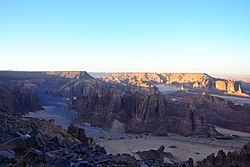Wadi al-'Ula
Wadi Al-ʿUla
وادي العلا | |
|---|---|
 Wadi Al-`Ula at sunset. | |
| Coordinates: 26°37′N 37°55′E / 26.617°N 37.917°E | |
| Country | |
| Region | Al Madinah |
Wadi al-'Ula is a wadi in western Saudi Arabia. Wadi Al Ula is a tributary of the Wadi Jizal.
The main town of the Wadi Al Ula' is AlUla.
history
About 4km from the modern town of AlUla are a set of ruins,[1][2] These ruins here are the remnant of a former Capital of the Dedanites, which was flourishing from 800BC to the 1st century. At this time the wadi was a stop on the spice routes. Agriculture and shepherding were the main economic staples of The Wadi s population at this time.
There was also a pilgrimage site in the hills nearby,[3] and the walls of the Wadi are covered with ancient pictographs.[4]
The city ceased in about 100AD with the control of the trade routes by the Nabataeans to the east and incursions by the Romans.
The wadi has been tentatively identified with Wadi al-Qura of early Islamic times.[5]
-
Wadi Al Ula 2012
-
ruins in Wadi Al Ula
-
"City of Lions" AlUla
-
Elephant rock AlUla, 2011.
Etymology
The name means “valley of villages”.[6]
References
- ^ Traveling Luck for Wādī al `Ulá, Saudi Arabia (general), Saudi Arabia.
- ^ Al‐Nasif, Abdallah (1981-01-01). "Al‐'Ula (Saudi Arabia): a report on a historical and archaeological survey". British Society for Middle Eastern Studies Bulletin. 8 (1): 30–32. doi:10.1080/13530198108705304. ISSN 0305-6139.
- ^ "al-Ula, Saudi Arabia". Archnet. Retrieved 2020-01-01.
{{cite web}}: CS1 maint: url-status (link) - ^ Al Ula .
- ^ Power, Timothy (2012). The Red Sea from Byzantium to the Caliphate: ad 500–1000. American University in Cairo Press. ISBN 978-977-416-544-3. JSTOR j.ctt15m7h9n.
- ^ Al Ula.







